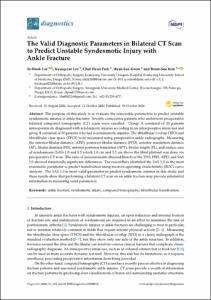KUMEL Repository
1. Journal Papers (연구논문)
1. School of Medicine (의과대학)
Dept. of Orthopedic Surgery (정형외과학)
The Valid Diagnostic Parameters in Bilateral CT Scan to Predict Unstable Syndesmotic Injury with Ankle Fracture
- Keimyung Author(s)
- Lee, Si Wook; Lee, Kyung Jae; Kim, Beom Soo
- Department
- Dept. of Orthopedic Surgery (정형외과학)
- Journal Title
- Diagnostics
- Issued Date
- 2020
- Volume
- 10
- Issue
- 10
- Abstract
- The purpose of this study is to evaluate the reasonable parameters to predict unstable syndesmotic injuries in ankle fractures. Seventy consecutive patients who underwent preoperative bilateral computed tomography (CT) scans were enrolled. Group A consisted of 20 patients intraoperatively diagnosed with syndesmotic injuries according to an intraoperative stress test and group B consisted of 50 patients who had nosyndesmotic injuries. The tibiofibular overlap (TFO) and tibiofibular clear space (TFCS) were measured using preoperative ankle radiographs. Measuring the anterior fibular distance (AFD), posterior fibular distance (PFD), anterior translation distance (AT), fibular diastasis (FD), anterior-posterior translation (APT), fibular length (FL), and surface area of syndesmosis (SAS) 1.0 and 1.5 which 1.0 cm and 1.5 cm above the tibial plafond was done via preoperative CT scan. The ratio of measurements (Injured/Intact) of the TFO, PFD, APD, and SAS 1.0 showed statistically significant differences. The researchers identified the SAS 1.0 as the most reasonable parameter to predict transfixation using receiver-operating characteristic (ROC) curve analysis. The SAS 1.0 is most valid parameter to predict syndesmotic injuries in this study and these results show that performing a bilateral CT scan on an ankle fracture may provide substantial information in measuring valid parameters.
- Publisher
- School of Medicine (의과대학)
- Citation
- Si-Wook Lee et al. (2020). The Valid Diagnostic Parameters in Bilateral CT Scan to Predict Unstable Syndesmotic Injury with Ankle Fracture. Diagnostics, 10(10), 812. doi: 10.3390/diagnostics10100812
- Type
- Article
- ISSN
- 2075-4418
- Source
- https://www.mdpi.com/2075-4418/10/10/812
- Appears in Collections:
- 1. School of Medicine (의과대학) > Dept. of Orthopedic Surgery (정형외과학)
- 파일 목록
-
-
Download
 oak-2020-0286.pdf
기타 데이터 / 1.12 MB / Adobe PDF
oak-2020-0286.pdf
기타 데이터 / 1.12 MB / Adobe PDF
-
Items in Repository are protected by copyright, with all rights reserved, unless otherwise indicated.